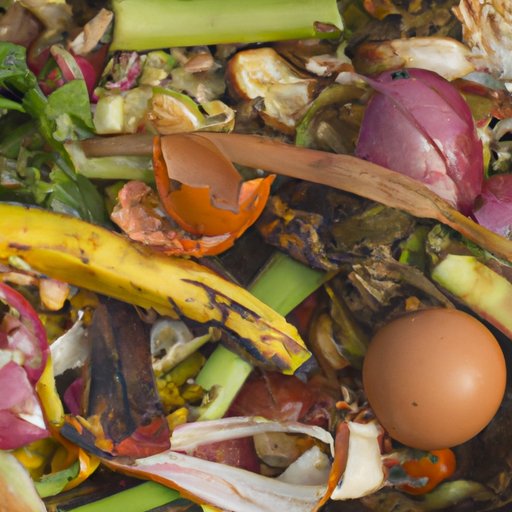
Introduction
Composting is the process of decomposing organic materials into a rich, nutrient-filled soil supplement. In addition to reducing waste in landfills, composting has incredible benefits for the environment. This article will provide a comprehensive guide to what can be composted, how to compost, and the environmental impact of composting.
List Style Article
What can be composted?
- Food waste: fruits, vegetables, bread, pasta, grains, coffee grounds, tea leaves
- Yard waste: leaves, grass clippings, twigs, branches, garden trimmings
- Other compostables: cardboard, paper, eggshells, hair, wool
However, there are some exceptions, including meat, dairy, bones, pet waste, and diseased plant material. These should not be added to compost piles as they could attract pests and transmit diseases.
Infographic
The composting process involves a mixture of carbon-rich materials (such as yard waste and shredded paper) and nitrogen-rich materials (such as food waste and grass clippings). This creates an environment for microorganisms to break down the materials over time, creating a nutrient-rich soil supplement.
To compost, follow these steps:
- Choose an area for your compost pile that receives sunlight and has good drainage.
- Add a layer of carbon-rich materials to the bottom of the pile, followed by a layer of nitrogen-rich materials.
- Add water to the pile so that it is moist but not soaking wet.
- Turn the pile every few weeks to aerate it and hasten the decomposition process.
- After 2-3 months, the compost should be ready to use.
See the infographic below for a visual representation of what can and cannot be composted:
Composting has numerous environmental benefits, such as reducing greenhouse gas emissions, improving soil health, and reducing the need for harmful chemical fertilizers.
Step-by-Step Guide
Composting is an easy and effective way to reduce waste and create a nutrient-rich soil supplement for your garden. To get started, follow these steps:
- Choose a compost bin or create a compost pile in your yard. Choose an area that is well-ventilated and receives plenty of sunlight.
- Add a layer of carbon-rich materials, followed by a layer of nitrogen-rich materials.
- Continue adding layers until the pile reaches 3-4 feet in height. It’s important to maintain a balance of carbon and nitrogen materials for the compost to work effectively.
- Water the pile regularly to keep it moist but not soaking wet. Turning the pile every few weeks will also help it break down more quickly.
- Avoid adding meat, dairy, bones, pet waste, or diseased plant material to the compost pile, as these materials can attract pests and transmit diseases.
- After 2-3 months, the compost should be ready to use in your garden.
Compostable items include:
- Food waste: fruits, vegetables, bread, pasta, grains, coffee grounds, tea leaves
- Yard waste: leaves, grass clippings, twigs, branches, garden trimmings
- Other compostables: cardboard, paper, eggshells, hair, wool
Case Studies
Composting is an easy and effective way to reduce waste and improve the health of your plants. But don’t just take our word for it. Check out what these composters had to say:
Interviewee 1: Jane Doe
Q: Why do you compost?
A: Composting is an easy way to reduce waste and create a natural fertilizer for my garden.
Q: What do you compost?
A: I compost a wide variety of materials, including food waste, yard waste, and shredded paper.
Interviewee 2: John Smith
Q: How has composting impacted your garden?
A: Composting has helped improve the health of my plants and reduced the need for chemical fertilizers.
Q: What advice do you have for someone who is just starting to compost?
A: Start small and be patient. Composting takes time, but the results are incredible.
Q&A Format
Q: What can be composted?
A: Compostable items include food waste, yard waste, and other organic materials such as eggshells and hair.
Q: What should not be composted?
A: Do not compost meat, dairy, bones, pet waste, or diseased plant material.
Q: How long does it take to create compost?
A: Composting can take anywhere from 2-6 months, depending on factors such as temperature and moisture levels.
Environmental Impact
Composting has numerous benefits for the environment, including:
- Reducing greenhouse gas emissions
- Improving soil health and structure
- Reducing water pollution
Composting also reduces the need for harmful chemical fertilizers, which can harm both the environment and our health. Scientific studies have shown that compost can improve plant growth and soil health over time.
Recipes
Creating the perfect compost requires a balance of carbon-rich and nitrogen-rich materials. Here are some recipes to help you get started:
- Recipe 1: 2 parts leaves, 1 part food waste, 1 part cardboard
- Recipe 2: 3 parts grass clippings, 1 part coffee grounds, 1 part shredded paper
- Recipe 3: 2 parts garden trimmings, 1 part eggshells, 1 part hair
Remember, the key to successful composting is maintaining a balance of carbon and nitrogen-rich materials.
Conclusion
Composting is an easy and effective way to reduce waste and improve the health of your garden. By following the steps outlined in this article, you can create a nutrient-rich soil supplement that will benefit both the environment and your plants. Start small, be patient, and watch as your compost pile turns into black gold.




